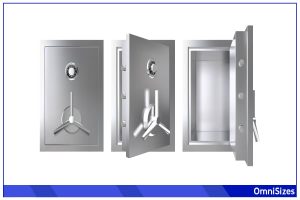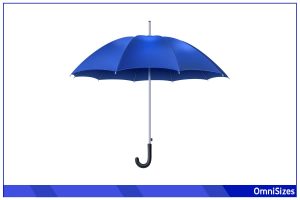Choosing the right toothbrush is more than just picking your favorite color—it’s about finding the perfect size for your mouth. Toothbrush sizes vary and affect how well you can clean different areas of your mouth.
The size of a toothbrush is determined by the length of its head, which varies between age groups.
- 0-2 years: 15 mm or 0.6 inch
- 2-6 years: 19 mm or 0.75 inch
- 6-12 years: 22 mm or 0.87 inch
- 12 years and older: 25 mm or 1 inch
Ideally, the toothbrush size you choose should reach your farthest teeth.
There’s quite a bit to unpack regarding toothbrush size. This guide will cover the basics of a toothbrush’s anatomy before diving into the different sizes of toothbrushes.
The Anatomy of a Toothbrush
To better understand the size of a toothbrush, you should first familiarize yourself with the different parts.
Brush Head Size
The size of the brush head is a critical factor in toothbrush selection. It varies to accommodate different mouth sizes and cleaning needs.
- Small: Small brush heads are designed for precision cleaning. They easily reach tight spaces in the mouth, so they’re ideal for children and adults with smaller mouths.
- Medium: Medium-sized brush heads are the most commonly used. They strike a balance between covering a larger surface area and accessing tight spaces. Suitable for most adults, these brush heads provide thorough cleaning for a range of mouth sizes.
- Large: Large brush heads cover more surface area with each stroke. However, they might be challenging to maneuver in smaller mouths and may not reach all areas effectively.
Bristle Variety
The bristles of a toothbrush come in various types. The choice of bristles depends on personal preference and gum sensitivity.
- Soft Bristles: Soft bristles are gentle on the gums and teeth. They are ideal for individuals with sensitive teeth, gum disease, or receding gums. Soft bristles effectively remove plaque and debris without causing damage to the enamel or gums.
- Medium Bristles: Medium bristles offer a firmer feel compared to soft bristles. They provide a more aggressive cleaning and are suitable for individuals without sensitivity issues.
- Hard Bristles: Hard, or firm, bristles are the stiffest. While they can remove plaque efficiently, they are generally not recommended as they can cause damage to the gums and tooth enamel, especially with aggressive brushing.
Size Considerations for Different Age Groups
The size of a toothbrush, particularly the length of its head, plays a significant role in its ability to clean teeth thoroughly and comfortably. Here’s a detailed look at the appropriate toothbrush sizes for various age groups.
Children’s Toothbrush Sizes
- 0-2 Years (15 mm or 0.6 inch): For infants and toddlers, a toothbrush with a head length of about 15 mm or 0.6 inch is ideal. This small size is perfect for their tiny mouths and emerging teeth. It allows for gentle cleaning without overwhelming their oral cavity, making brushing a comfortable experience for both the child and the parent.
- 2-6 Years (19 mm or 0.75 inch): As children grow, their mouths and teeth develop, requiring a slightly larger toothbrush. A toothbrush head measuring 19 mm or 0.75 inch is suitable for this age group. It’s large enough to clean the increased number of teeth effectively while still fitting comfortably in their small mouths.
- 6-12 Years (22 mm or 0.87 inch): School-aged children need a toothbrush size that can handle their mixed dentition, consisting of both primary and permanent teeth. A toothbrush head around 22 mm or 0.87 inch is recommended. It reaches all teeth, including the molars at the back of the mouth, ensuring thorough cleaning as they learn proper brushing techniques.
Adult Toothbrush Sizes
12 Years and Older (25 mm or 1 inch): From the age of 12 and onwards, a full adult-sized toothbrush is appropriate. The ideal head length is about 25 mm or 1 inch. This size is designed to comfortably reach the farthest teeth, like the molars, and cover more surface area per stroke. It ensures that all parts of the mouth, including hard-to-reach areas, are effectively cleaned.
Special Needs and Toothbrush Sizes
The right toothbrush will cater to all your dental hygiene needs. Those with braces, sensitive teeth, or limited dexterity might need a specific toothbrush that addresses their special conditions.
Orthodontic Needs
For those with braces or aligners, smaller toothbrush heads are generally more effective. They allow for better maneuverability around wires and brackets, ensuring a thorough clean. A compact head, typically around 0.75 to 1 inch, can reach the nooks and crannies around orthodontic appliances.
Sensitive Gums and Teeth
People with sensitive gums and teeth benefit from smaller, softer-bristled toothbrushes. The compact size allows for gentle, precise brushing without irritating sensitive areas. A toothbrush head around 0.75 to 1 inch, combined with ultra-soft bristles, can provide a comfortable brushing experience while effectively cleaning the teeth.
Limited Mobility and Dexterity
For individuals with limited hand mobility or dexterity, such as arthritis sufferers, the toothbrush handle is as significant as the head size. Ergonomically designed handles, which are often thicker and easier to grip, can greatly enhance the brushing experience. While the head size might remain standard (around 1 inch for adults), the modified handle design allows for better control and comfort during brushing.
Electric Toothbrush Sizes
Electric toothbrushes have become increasingly popular due to their efficiency and ease of use.
Standard Size Electric Toothbrushes
Standard size electric toothbrushes are designed for adult use. They typically have a head size around 1 inch, similar to manual toothbrushes, but with added benefits. The bristles oscillate or vibrate, providing a more thorough clean than manual brushing.
Compact Size Electric Toothbrushes
Compact electric toothbrushes are smaller in size, with a head around 0.75 inches. These are specifically designed for children or adults with smaller mouths. The compact size allows for easier access to all areas of the mouth, especially for those who might find larger brush heads cumbersome.
Features to Consider
- Brush Head Movement: Different electric toothbrushes offer various types of head movements—oscillating, rotating, or vibrating. The choice depends on personal preference and dental needs.
- Timer and Pressure Sensors: Most electric toothbrushes come with built-in timers to ensure you brush for the recommended two minutes. Pressure sensors alert you if you’re brushing too hard, protecting your gums and enamel.






